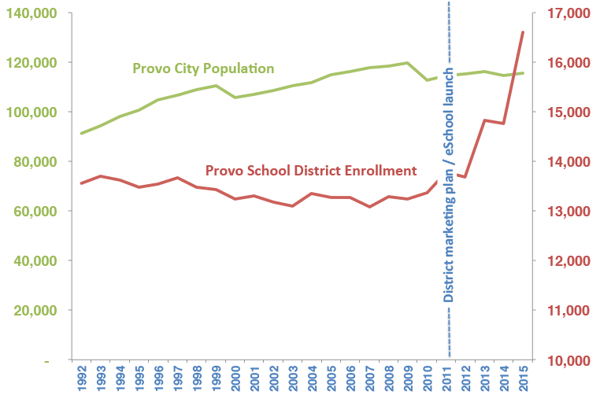How To Stop Charter Schools From Growing
The Growth of Charter Schools
Yep...charter schools are popping up like crazy all over the country, and particularly in California (see one of our previous blogs on this subject here). It's true - more and more California families are choosing charter schools. From experience and research, it's probably due to a combination of factors, such as:
- Students had a bad experience at a traditional public school
- It's a new concept, and many people are open to trying out new things
- Smaller class sizes, or at least the perception of such
- A small school experience
- Charter schools are better at marketing because they have to be
The Impact on School Districts
Whatever the reasons are for choosing charter schools, it's happening, and this makes school districts very nervous because school districts are funded by student enrollment. And it's not so simple as to expect districts costs will go down commensurately with less students because school districts have substantial overhead and fixed costs that are going to remain even if students leave to go elsewhere.
Strategies to Slow Charter Schools Down
Now that it's established that charter schools are growing, and as a result some school districts are losing enrollment - which furthermore is impacting financial solvency - let's talk about the three primary strategies districts have employed and can employ to fight back:
1. Legislate
This is a popular choice, and it's happening everywhere in the 43 states (and counting) where charter schools are allowed to exist. In this option, school districts lobby state lawmakers to enact laws to inhibit charter school growth. Or even shut them down. The pieces of legislation introduced vary widely, from wanting to shut down charter schools completely (and, in the case of California, making 600,000 students "choose" schools that they don't really want to go to), to enacting laws that make it more difficult for charter schools to compete, to laws that make charter schools more accountable (these are the good ones that help everyone).
Legislation that requires all schools to be more accountable is the proverbial rising tide that lifts all boats. Legislation that levels the playing field for districts and charters is good too. It's good for students, families, taxpayers, and the districts and schools themselves. But when legislation has the obvious fingerprints of certain school districts who are protecting their own interests only, causing harm to school choice, it's a different story. That's not good legislation.
2. Litigate
This is another popular choice for school districts to employ to limit the growth of charter schools. It's popular because school districts can afford to pay for it, and often charter schools can't. In this option, school districts with deeper pockets than charter schools sue to protect their financial interests. Like the "legislate" option above, there are varying levels of impact when it comes to litigation, from shutting charter schools down completely to restricting student access to them.
In education, there unfortunately are valid and reasons where legal action has to be taken, but again this discussion is about using litigation as a means to artificially reign in charter school enrollment growth.
3. Lead
The final choice is my favorite - to become a market leader by using distinct competitive advantages to create demand, and thus recapture student enrollment that has gone to charter schools. Becoming a market leader is the most difficult option at first, and often requires a substantial overhaul to the district's schools and the district itself. But it's by far the best option for long-term growth, and it's the only choice with enough runway to get school districts off the ground and flying. It also impacts student achievement (imagine every student wanting to be there, rather than being forced to be because their top choices were taken away).
This approach works, because it forces school districts and charter schools to be accountable to their customers, and to deliver a school experience that families and students actually want and need. All of this can be done within a framework that protects the interests of taxpayers.
The Great Comeback: A School District Success Story
I've seen the benefits of Option 3 firsthand. I worked for a school district in Utah for 14 years in various business capacities. Most of my time there was spent trying to improve the district's financial situation - the bottom line - and the top line - as we often said. Basically, to holistically improve our financial position by increasing revenues and decreasing expenditures.
The inspiration for cutting costs was simple: a large component of the District's funding came from property taxes, and the housing market crash of 2006 to (choose your ending date) was killing property values and jobs, which further impacted personal income tax, the biggest component of Utah school funding. A double whammy. We had no choice...we needed to " confront the brutal facts", as Jim Collins says in his landmark business book Good To Great. But it didn't take long to get to a point where there just weren't many more costs to cut. Like any business, some school district costs are fixed, and can't be cut, even when business is down. Some are "legacy" costs that are the result of decisions made years earlier. Some costs are related to school buildings already in service (a quick note: we need to face it: school districts often have substantial fixed costs that aren't the result of bad business decisions. This is a true disadvantage faced by school districts that can't be overstated).
After many painful expenditure budget cuts that impacted everyone, we next focused on the top line, which were revenues stemming primarily from student enrollments. But we had a problem: a few years back, charter schools had begun to pop up all over in Utah, and these schools were basically eating our lunch. The charters were offering what the people wanted, and students were leaving by the busload. In many cases, the charters offered fresh new approaches to education. In others, they weren't "school district schools" and that's all that mattered. Either way, the charter schools weren't saddled with some of the same fixed costs that we were stuck with at the school district.
Despite moderate population growth in Provo, the city from where the District's enrollments originated, enrollment was flat, and in many years declining. We needed to do something truly extraordinary, and to cite a cliche´, innovative, to fix what was obviously broken in the minds of our customers (and those we had lost).
At Provo, we decided to choose Option 3 - to Lead. We set out to become a market leader. We became customer-centric, and we didn't take student enrollments for granted. Students had choices, we knew it, and we acted like it. We built a marketing plan and executed it. The marketing plan called for updated modalities for educating students, with online learning what we referred to as the "tip of the spear." We built an online school and a blended learning school. We built specialty online schools focused on tech and foreign languages. We listened to our customers, and actually put many of their ideas into action. Basically, we went through a process of refining the District's products and services to address what the market wanted. And the best part was that we didn't break the budget to start any of these extensions of our district's product line. To the contrary, these strategies become a budget lifeboat, and eventually made us a much stronger, wiser, and more seaworthy vessel.
Fairly quickly the results became evident and enrollment spiked, in spite of statewide charter school expansion and stagnant population growth in the city as a whole. Below is a chart comparing Provo School District Enrollment and the population of Provo City, which constituted the service area of the school district. The chart time period spans nearly a quarter century. We began implementing our marketing strategy in 2011, which appears on the chart as well:
Provo School District Enrollment vs. Provo City Population
(District service area = Provo City limits)

We learned that we had distinct competitive advantages that could be leveraged to become a market leader. It was an impressive comeback. The District, after years of being disrupted by start up charter schools, disrupted the charter schools back. The Mark Twain quote " The reports of my death are greatly exaggerated" comes to mind when I think of what we were able to achieve as a district. Simply put, school districts - and the schools they oversee - have a lot to offer students and families - even in a world of school choice.
Learning More and Moving Forward
When we set out to build Method, one of the things I wanted was to have both of my kids to attend one of our centers - kind of a parent-forced form of school choice. I really believed in what we were going to deliver, and still do believe Method is the top choice for many students in the areas we serve. After enrolling both of my children, it was apparent one was thriving, and loved Method. The other didn't - he needed a more traditional school experience. Eventually we transferred him back to his traditional neighborhood school and he's never been happier. Meanwhile, his sister continues to thrive at Method. As is often said, one size doesn't fit all. Like my experience at Provo School District, I've learned about the importance of school choice firsthand.
Districts and Charters are Partners in the K-12 Education Community, and Should Act Like it
At Method, we're fortunate to operate in areas with good school districts. The kind of districts that "get it." Our authorizing districts, Dehesa and Acton Agua Dulce come to mind. Murrieta Valley Unified and Arcadia Unified do as well. These districts are known throughout the State of California to get a positive return on investment of public tax dollars. And there are many more districts out there offering the public the same high quality choices. Even though it isn't a requirement, we go out of our way to get approval from these and other districts before enrolling students who are attempting to transfer to Method. We value our position at the education table with these school districts that much. Again, there are many more districts just like these in the areas we operate - districts that are focused on being market leaders.
Charters Have Responsibility Too
Finally, charter schools need to improve too. There are far too many charter schools out there that aren't delivering results that students, families, and taxpayers can be proud of. From experience, starting up a charter school isn't easy. There are systems, processes, and resources available to school districts that charter schools just don't have access to - at least during the start up years. During the first year at Method, at time it felt like a comedy of errors. But we learned, and continue to. We got better, and continue to.
Hopefully the K-12 education community in California and beyond can find ways to choose Option 3, and to Lead - to become customer-centric market dominators. We all need to get better - for California's students, and for all students. When that happens, students, families, taxpayers, and the schools themselves win, and the only schools that don't make it - whether a traditional school or a charter school - are those that didn't meet the needs of their customers.

Mark Holley
Mark Holley is Co-Founder & Chief Business Officer at Method Schools, a California charter school network dedicated to personalized, student-centered learning. Learn more at methodschools.org.



-1.svg)
.svg)
-1.svg)
.svg)
.svg)

.svg)










.svg)
.svg)




